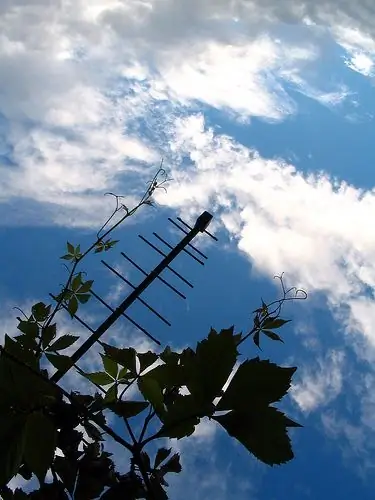Spending holidays in the country, we are in no hurry to give up the comfort of city life. One of these elements is a television. But, in order for it to receive various channels, it should be equipped with an antenna. There is an opportunity to do it yourself, observing the basic principles.

It is necessary
copper, brass, steel or aluminum tube, plate or bar, coaxial cable, dielectric
Instructions
Step 1
Take copper tape, tube, or other metal profile. In this case, keep in mind that high-frequency currents propagate in a thin layer of the metal surface. In this regard, it does not matter what is taken for the manufacture of the antenna - a bar or a tube, only the outer diameter is important. When a metal strip is used for the antenna, its width should be almost 1.5 times the calculated diameter. A TV antenna can be made of any metal: brass, copper, bronze, aluminum, steel, but its surface should be smooth and even. The steel antenna will be heavy, besides it rusts, thereby deteriorating its performance. Most often, antennas are made of aluminum alloys, however, an oxide poorly conducting film is created on their surface. The best electrical parameters are for brass and copper.
Step 2
The main parameters of the loop antenna: copper tape - thickness 1, 2 mm, width - 6, 5 mm; total length for receiving 1-5 channels - 3500 mm, from 6 to 12 - 1290 mm; total loop length - for 1-5 (49-100 MHz) is 1230 mm, 6-12 (175-227 MHz) - 470 mm; the distance between the ends of the copper tape is 60 mm, the ends of the loop are soldered to them; a 60 mm long steel plate located at the top of the hinge is used to connect the "shield". The two parts of the copper plate after the loops are delimited by a dielectric.
Step 3
Seal to protect from moisture where the coaxial cable connects to the antenna elements. It is best to use plasticized epoxy resins for these purposes. To avoid corrosion of the antenna after assembling and connecting the cable, paint it in several layers, before that, first degrease the surface. Use paints that are able to withstand external climatic factors and have good dielectric properties, for example, nitro enamel, car enamel, in extreme cases, oil paints can be used.
Step 4
Determine the characteristic impedance of your cable. It is measured with special high-frequency instruments. A loop is used for the interaction of an antenna with a characteristic impedance of 292 Ohm with a 75 Ohm cable. Do not use a 50 ohm cable instead of a 75 ohm cable, this will cause ghosting and ripple on the screen, thereby significantly degrading the picture quality. Aim the antenna for minimum reflected noise, not maximum signal.






